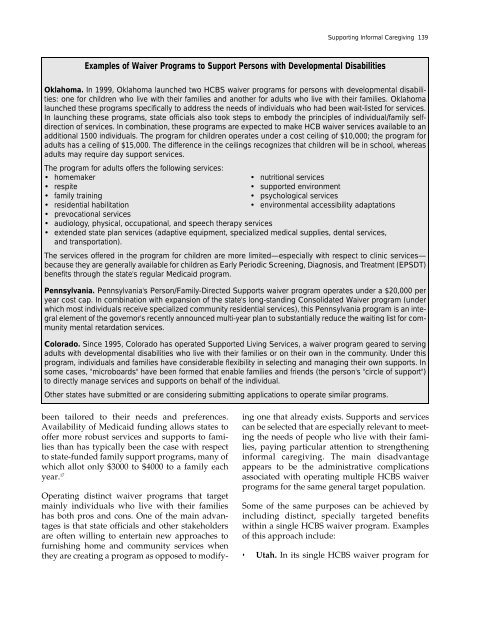Full PDF Version - ASPE - U.S. Department of Health and Human ...
Full PDF Version - ASPE - U.S. Department of Health and Human ...
Full PDF Version - ASPE - U.S. Department of Health and Human ...
- No tags were found...
You also want an ePaper? Increase the reach of your titles
YUMPU automatically turns print PDFs into web optimized ePapers that Google loves.
Supporting Informal Caregiving 139Examples <strong>of</strong> Waiver Programs to Support Persons with Developmental DisabilitiesOklahoma. In 1999, Oklahoma launched two HCBS waiver programs for persons with developmental disabilities:one for children who live with their families <strong>and</strong> another for adults who live with their families. Oklahomalaunched these programs specifically to address the needs <strong>of</strong> individuals who had been wait-listed for services.In launching these programs, state <strong>of</strong>ficials also took steps to embody the principles <strong>of</strong> individual/family selfdirection<strong>of</strong> services. In combination, these programs are expected to make HCB waiver services available to anadditional 1500 individuals. The program for children operates under a cost ceiling <strong>of</strong> $10,000; the program foradults has a ceiling <strong>of</strong> $15,000. The difference in the ceilings recognizes that children will be in school, whereasadults may require day support services.The program for adults <strong>of</strong>fers the following services:• homemaker• nutritional services• respite• supported environment• family training• psychological services• residential habilitation• environmental accessibility adaptations• prevocational services• audiology, physical, occupational, <strong>and</strong> speech therapy services• extended state plan services (adaptive equipment, specialized medical supplies, dental services,<strong>and</strong> transportation).The services <strong>of</strong>fered in the program for children are more limited—especially with respect to clinic services—because they are generally available for children as Early Periodic Screening, Diagnosis, <strong>and</strong> Treatment (EPSDT)benefits through the state's regular Medicaid program.Pennsylvania. Pennsylvania's Person/Family-Directed Supports waiver program operates under a $20,000 peryear cost cap. In combination with expansion <strong>of</strong> the state's long-st<strong>and</strong>ing Consolidated Waiver program (underwhich most individuals receive specialized community residential services), this Pennsylvania program is an integralelement <strong>of</strong> the governor's recently announced multi-year plan to substantially reduce the waiting list for communitymental retardation services.Colorado. Since 1995, Colorado has operated Supported Living Services, a waiver program geared to servingadults with developmental disabilities who live with their families or on their own in the community. Under thisprogram, individuals <strong>and</strong> families have considerable flexibility in selecting <strong>and</strong> managing their own supports. Insome cases, "microboards" have been formed that enable families <strong>and</strong> friends (the person's "circle <strong>of</strong> support")to directly manage services <strong>and</strong> supports on behalf <strong>of</strong> the individual.Other states have submitted or are considering submitting applications to operate similar programs.been tailored to their needs <strong>and</strong> preferences.Availability <strong>of</strong> Medicaid funding allows states to<strong>of</strong>fer more robust services <strong>and</strong> supports to familiesthan has typically been the case with respectto state-funded family support programs, many <strong>of</strong>which allot only $3000 to $4000 to a family eachyear. 17Operating distinct waiver programs that targetmainly individuals who live with their familieshas both pros <strong>and</strong> cons. One <strong>of</strong> the main advantagesis that state <strong>of</strong>ficials <strong>and</strong> other stakeholdersare <strong>of</strong>ten willing to entertain new approaches t<strong>of</strong>urnishing home <strong>and</strong> community services whenthey are creating a program as opposed to modifyingone that already exists. Supports <strong>and</strong> servicescan be selected that are especially relevant to meetingthe needs <strong>of</strong> people who live with their families,paying particular attention to strengtheninginformal caregiving. The main disadvantageappears to be the administrative complicationsassociated with operating multiple HCBS waiverprograms for the same general target population.Some <strong>of</strong> the same purposes can be achieved byincluding distinct, specially targeted benefitswithin a single HCBS waiver program. Examples<strong>of</strong> this approach include:• Utah. In its single HCBS waiver program for
















